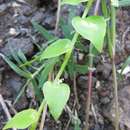en
names in breadcrumbs


Callisia is a genus of flowering plants in the spiderwort family, Commelinaceae. Members of the genus are commonly known as roselings.[3] It is native to the Western Hemisphere from the southern United States to Argentina.[2][4][5][6] The generic name is derived from the Greek word κάλλος (kallos), meaning "beauty."[7]
Some members of Callisia may cause allergic reactions in pets (especially cats and dogs), characterised by red, itchy skin. Notable culprits are C. fragrans (inch plant) and C. repens (turtle vine).
Callisia includes the following species:[2][3][8]
{{cite web}}: CS1 maint: archived copy as title (link). Jardim Botânico do Rio de Janeiro, Rio de Janeiro Callisia is a genus of flowering plants in the spiderwort family, Commelinaceae. Members of the genus are commonly known as roselings. It is native to the Western Hemisphere from the southern United States to Argentina. The generic name is derived from the Greek word κάλλος (kallos), meaning "beauty."
Some members of Callisia may cause allergic reactions in pets (especially cats and dogs), characterised by red, itchy skin. Notable culprits are C. fragrans (inch plant) and C. repens (turtle vine).